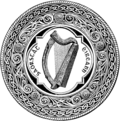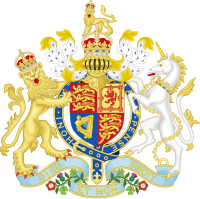Monarchy in the Irish Free State
This article has multiple issues. Please help improve it or discuss these issues on the talk page. (Learn how and when to remove these messages)
|
| Monarchy of the Irish Free State | |
|---|---|
 | |
| Details | |
| Style | His Majesty |
| First monarch | George V |
| Last monarch | George VI |
| Formation | 6 December 1922 |
| Abolition | 29 December 1937 |
| Residence | Viceregal Lodge |
From its foundation on 6 December 1922 until 11 December 1936, the Irish Free State was in accordance with its constitution, governed formally under a form of constitutional monarchy. The monarch exercised a number of important duties, including appointing the cabinet, dissolving the legislature and promulgating laws. Nonetheless, by convention the monarch's role was largely ceremonial and exercised on his behalf by his official representative, the governor-general. The monarch's role and duties under the constitution were ended under a constitutional amendment adopted in 1936. From that point, the monarch no longer played any role in appointing the cabinet, dissolving the legislature or promulgating laws. Nor was the monarch mentioned anywhere in the constitution. Under separate legislation also adopted in 1936 it was provided that Irish diplomatic representatives would be appointed on the authority of the cabinet alone and international agreements would be concluded with the authority of the cabinet alone. At the same time, that legislation also created a new role for the king in his capacity as the "symbol of [the] co-operation" of Australia, Canada, Great Britain, New Zealand, and South Africa for so long as the Irish Free State was associated with those states. The new role of the king in that capacity alone was to act on behalf of the Irish government with respect to the appointment of diplomatic and consular representatives and the conclusion of international agreements when advised by the cabinet so to do. The role of the king in acting on behalf of the Irish government with respect to appointing diplomats was not ended until 1949[1] and under United Kingdom law the king is regarded as having been the sovereign until that time but not under Irish law.
Monarchical title

The monarch's title in the Irish Free State was exactly the same as it was elsewhere in the British Empire, being
- 6 December 1922 – 13 May 1927 – By the Grace of God, of the United Kingdom of Great Britain and Ireland and of the British Dominions beyond the Seas King, Defender of the Faith, Emperor of India
- 13 May 1927 – 29 December 1937 – By the Grace of God, of Great Britain, Ireland and the British Dominions beyond the Seas King, Defender of the Faith, Emperor of India
The reason the monarch's title changed in 1927 was because the term "United Kingdom of Great Britain and Ireland" had been superseded by the establishment of the Irish Free State and the renaming of the UK as the "United Kingdom of Great Britain and Northern Ireland". Rather than draw attention to the partition of Ireland, the monarch's title simply referred to Great Britain and Ireland. This change did not mean the monarch adopted different crowns for different realms; that development did not formally occur until 1953.
Duties and functions
- Executive authority: The executive authority of the state was formally vested in the monarch but 'exercised' by the governor-general, on the 'advice' of the Executive Council.
- Appointment of the cabinet: The President of the Executive Council (prime minister) was appointed by governor-general after being selected by Dáil Éireann (the lower house of parliament). The remaining ministers were appointed on the nomination of the president, subject to a vote of consent in the Dáil.
- Convention and dissolution of the legislature: The governor-general, on behalf of the monarch, convened and dissolved the Oireachtas on the advice of the Executive Council.
- Signing bills into law: The monarch was formally, along with the Dáil and the Senate, one of three tiers of the Oireachtas. No bill could become law until it received the Royal Assent, given by the governor-general on behalf of the monarch. The governor-general theoretically had the right to veto a bill or reserve it "for the signification of the King's pleasure", in effect postponing a decision on whether or not to enact the bill, for a maximum of one year. However neither of these two actions was ever taken.
- Representative of the state in foreign affairs: The monarch accredited ambassadors and received the letters of credence of foreign diplomats; ministers signed international treaties in his name. The role of the monarch in the Free State's foreign affairs was the only function retained by him after the constitutional changes of 1936.
- Appointment of judges: All judges were appointed by the governor-general, on the advice of the Executive Council.
Oath of Allegiance
Under the Free State constitution, members of the Oireachtas were required to take an Oath of Allegiance to the Irish Free State with a promise of fidelity—but not allegiance—to the monarch before being permitted to assume their seats. This oath was strongly objected to by many republicans and was one of the causes of the Irish Civil War. The oath was eventually abolished in 1933. The Oath of Allegiance read as follows:
- I ................ do solemnly swear true faith and allegiance to the Constitution of the Irish Free State as by law established, and that I will be faithful to H. M. King George V., his heirs and successors by law in virtue of the common citizenship of Ireland with Great Britain and her adherence to and membership of the group of nations forming the British Commonwealth of Nations.
Diminished role

Fianna Fáil came to power after the 1932 election and reduced the role of the monarchy. The oath of fidelity to the king required of legislators and ministers was abolished. A compliant governor-general was appointed, Domhnall Ua Buachalla, who withdrew from all public and ceremonial roles, performing in a perfunctory manner the minimum duties required by the Constitution. No treaties requiring the assent of the king as head of state were signed from 1931 to 1937; two methods were used to circumvent this: bilateral treaties were concluded at government rather than head-of-state level; for multilateral treaties, the Free State chose, not to enrol at inauguration via the king's signature, but instead to accede a few months later via the signature of the Minister for External Affairs.[2]
In 1936, the government of Éamon de Valera carried out a major revision of the constitution aimed at all but eliminating the role of the monarch in the Irish state. The parliament passed the Constitution (Amendment No. 27) Act 1936, which removed all explicit reference to the monarch from the constitution, abolished the office of governor-general, and shared all of the monarch's former functions amongst various other organs of government.
However, without mentioning him by name, the amendment also introduced a provision permitting the government to "avail of" the monarch as a "constitutional organ" for the "appointment of diplomatic and consular agents and the conclusion of international agreements". Thus, henceforth, the sovereign's role was restricted to diplomatic and foreign affairs, a standard head of state role. The monarch retained no other constitutional role internally in the life of the Irish state and was relegated in the 1937 Constitution of Ireland to being an unnamed "organ" used by the state should it choose in statute law to do so. The role continued until the enactment of the Republic of Ireland Act 1948, by which it was transferred to the President of Ireland. At that time, the new republic also ceased to be a member of the British Commonwealth.
List of monarchs
| No. | Name (Birth–Death) |
Reign | Governors-General | Presidents of the Executive Council | |
|---|---|---|---|---|---|
| 1. | George V (1865–1936) |
6 December 1922 | 20 January 1936 | Timothy Healy (1922–28) James McNeill (1928–32) Domhnall Ua Buachalla (1932–36) |
W. T. Cosgrave (1922–32) Éamon de Valera (1932–36) |
| 2. | Edward VIII (1894–1972) |
20 January 1936 | 11 December 1936 | Domhnall Ua Buachalla (1932–36) | Éamon de Valera (1932–36) |
| 3. | George VI (1895–1952) |
11 December 1936 | 29 December 1937[3] | Office abolished | Éamon de Valera (1936–37) |
See also
- History of the Republic of Ireland
- Style of the British Sovereign
- Monarchy in Ireland
- Irish head of state from 1936 to 1949
Notes
- ^ In the words of Mary E. Daly (January 2007). "The Irish Free State/Éire/Republic of Ireland/Ireland: "A Country by Any Other Name"?". Journal of British Studies. 46 (1): 72–90. doi:10.1086/508399. JSTOR 10.1086/508399.: "After the enactment of the 1936 External Relations Act and the 1937 Constitution, Ireland's only remaining link with the crown had been the accreditation of diplomats. The president of Ireland was the head of state. When opposition deputies asked de Valera whether Ireland was a republic—a favorite pastime in the mid-1940s—he tended to resort to dictionary definitions showing that Ireland had all the attributes of a republic."
- ^ Stewart, Robert B. (1938). "Treaty-Making Procedure in the British Dominions". The American Journal of International Law. 32 (3): 467–487: 480–485. doi:10.2307/2191164. ISSN 0002-9300. JSTOR 138434.
- ^ The date on which the present Constitution of Ireland came into force, creating the office of President of Ireland and abolishing the Irish Free State.

